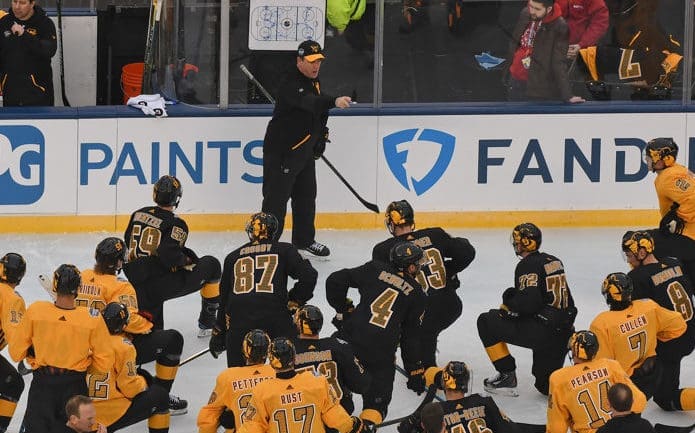Penguins
These Penguins Are Mike Sullivan’s Best Coaching Job

Rescuing a team and an organization from darkness in 2016 was an extraordinary task and one performed brilliantly by Pittsburgh Penguins head coach Mike Sullivan. By December 2016, the Pittsburgh Penguins core players were bickering amongst themselves, the team was in disarray and headed to an ignominious end with only the 2009 Stanley Cup to show for an unrivaled wealth of talent. Sullivan remarkably changed the hardened and negative team culture to a determined juggernaut which won two more Stanley Cups.
And yet the job Sullivan has done in 2018-19 might be even better.
An unhappy third line center, only one right-handed defenseman after Justin Schultz broke his leg, and an old and stale roster with more apathy towards the task at hand than motivation saddled the Penguins in the first half of the season. Coupled with the changing NHL game, the Penguins were all but dead in the water. Figuratively, of course.
Early in the process, Sullivan recognized the changing NHL and modernized his preachings and teachings. Isn’t that a far cry from the more cemented, “Get to our game,” mantra of Dan Bylsma who was the last successful head coach in Pittsburgh.
Sullivan pushed his team to “play hard below the dots”, “hang onto pucks,” be “tough to play against,” and to “simplify our game.” He used those phrases and similar numerous times through November and December, often with the tag line “this is where we think the NHL game is headed.”
Last season, Sullivan watched the Washington Capitals beat not only his team but then punish and pummel the Tampa Bay Lightning in the Eastern Conference Final. Washington wasn’t easy on Vegas, either as Washington lifted the Stanley Cup.
And Sullivan adjusted to the competition.
Getting the Penguins to adopt a harder style with players who found no joy in November hockey, much less stick to the original philosophy was like watching a coach herd cats.
But Sullivan didn’t waver.
Derrick Brassard was unhappy because he felt underutilized. Phil Kessel and Evgeni Malkin wanted to play together despite treating the puck like a hot potato, the defensive blue line like a stop sign and the offensive high zone like a swap meet. Daniel Sprong was dead weight, but the organization really wanted to see him blossom. And Matt Murray looked like a sieve.
All of that in addition to the lack of right-handed defensemen, an unmotivated team, and the NHL evolution. The only thing missing from the list was the partridge in a pear tree.
Sullivan created space for the heavy play of increasingly offensively gifted winger Zach Aston-Reese. He pushed Murray by handing starts to backup Casey DeSmith. He benched Phil Kessel for most of a third period in December win over Carolina and benched Jake Guentzel in the middle of a game, too.
Remember the final media availability before the All-Star break in January? Sullivan flatly said, as did some players, when the team returned they needed everyone to “buy in.”
Throughout the season, Sullivan and the coaches kept tinkering with lines to find hot hands and momentary sparks just to get by until reinforcements arrived. In December, GM Jim Rutherford acquired Marcus Pettersson for Sprong which significantly improved the Penguins defense but Sullivan had to find the right defensive pairings. And he was forced to keep juggling forward lines to find enough offense through January.
As the Penguins began their turnaround in later December, Sullivan pushed harder for more gritty play. The fourth line became successful with hard cycling in the low zone. Forwards began to pay some attention to defense. The Penguins moved from the bottom of the Eastern Conference to the middle.
On Feb. 1, Rutherford shed the frustrated Brassard and the superfluous Riley Sheahan (and draft picks) for a pair of versatile players: Jared McCann and Nick Bjugstad.
It looks easy in hindsight (and some crazy writer did opine in early February that McCann would be a great fit as an LW and Bjugstad as the 3C), but Sullivan had to find where the new pieces fit in the puzzle with the corner pieces including Malkin and Kessel.
Sullivan had to fit those pieces fit AND get the team to buy in.
It was adversity which brought it all together when Brian Dumoulin and Kris Letang were injured in the first period of the Stadium Series game on Feb. 23. The Penguins forwards rallied around the defensemen and the team played a simple, grinding game and dominated Philadelphia (despite an overtime loss).
It must have been fun because the team maintained that style for weeks and has primarily kept at it. The 2018-19 Pittsburgh Penguins are playing defense, challenging teams in all three zones, working hard along the walls and most players are chipping the puck ahead to open space instead of forcing the rush when it is not available.
The Penguins resemble a gritty, hungry team primed for a playoff run. They do not resemble the team which hit the ice and the bottom of the Eastern Conference in November.
And that is why this is Mike Sullivan’s best coaching performance.












